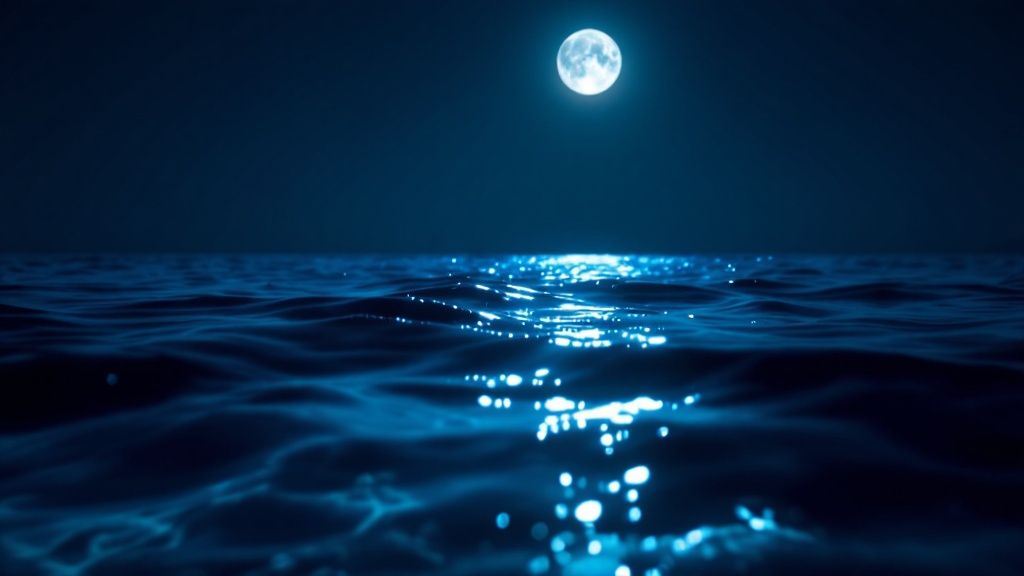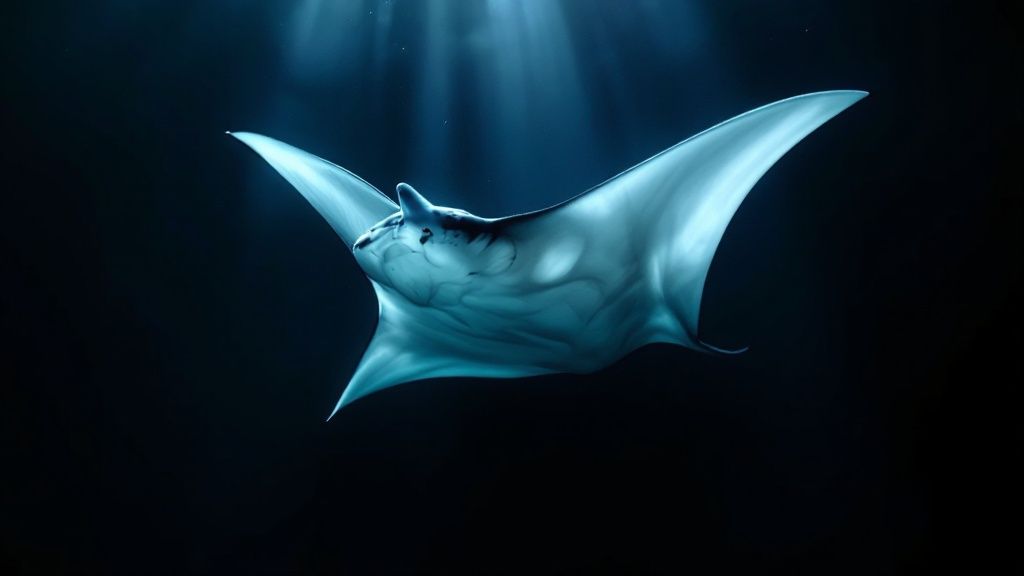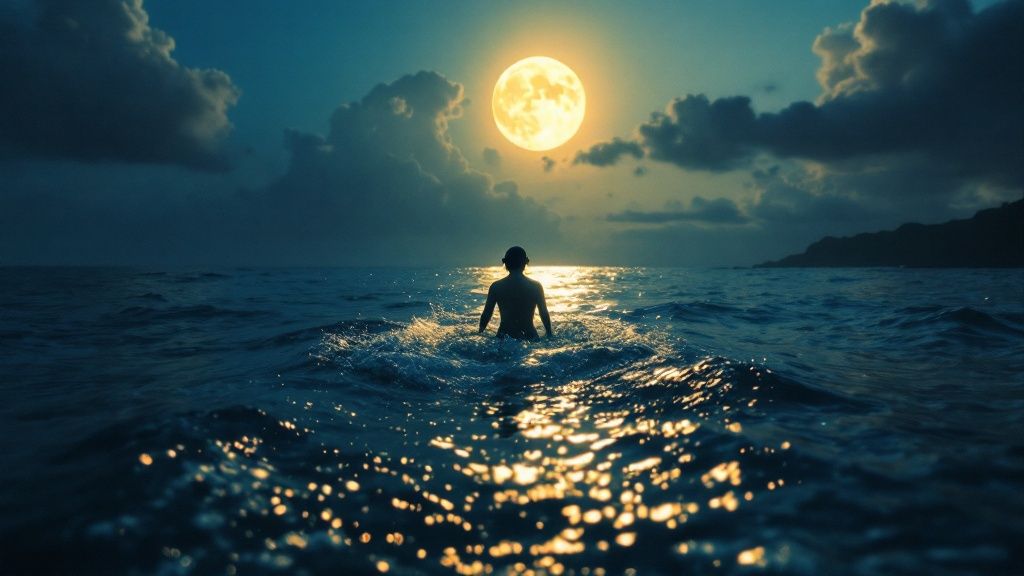Kona Manta Ray Night Snorkel Adventure
- Byron
- Mar 10
- 11 min read
The Mystical World of Kona Manta Ray Night Snorkeling
Stepping into the Pacific Ocean for a Kona manta ray night snorkel is like entering another dimension. It's not just snorkeling; it's an immersive experience that consistently captivates both visitors and locals. The Kona coast offers the perfect backdrop for observing these graceful creatures, a harmonious blend of clear waters, plentiful plankton, and ongoing conservation efforts. This unique combination distinguishes the Kona manta ray night snorkel from other wildlife encounters.
A key element of this magical experience is the interplay of darkness, light, and ocean currents. As the sun sets, the ocean transforms into a mysterious realm, illuminated by the gentle glow of underwater lights. These lights aren't merely for ambiance; they attract plankton, the manta rays' primary food source. This gives snorkelers a privileged view of a remarkable natural spectacle: the manta rays' nightly feeding ritual.
This predictable feeding pattern is a crucial part of what makes the Kona manta ray night snorkel so special. Unlike migratory animals, manta rays stay near the Kona coast year-round, providing reliable sightings for snorkelers and divers, sustained by the constant supply of phytoplankton. Local tour operators like Kona Honu Divers report manta ray sightings on over 80% of their night excursions, with an average of 5 to 6 mantas per night. This consistency makes Kona a prime location for manta ray encounters, creating an unforgettable experience under the stars as these gentle giants glide through the illuminated waters.
Understanding the Manta Ray's Nighttime World
The darkness plays a vital role in enhancing the Kona manta ray night snorkel. Reduced visibility heightens other senses, creating a more intimate encounter. Imagine floating in the dark ocean, feeling the cool water as you watch these enormous, graceful creatures illuminated by the underwater lights. The experience becomes almost surreal, fostering a deeper connection with these magnificent animals. It offers a truly unique perspective on marine life.
The Kona manta ray night snorkel offers more than just a glimpse of these majestic creatures; it's a chance to observe their natural behavior in a uniquely captivating way. This experience fosters a deeper appreciation for marine life and highlights the importance of conservation.
Prime Seasons and Secret Spots for Manta Encounters
Timing is everything when it comes to experiencing the magic of a Kona manta ray night snorkel. Understanding how the seasons influence manta ray behavior will help you plan the perfect encounter. While mantas grace the Kona coast year-round, certain times offer unique advantages.
Seasonal Variations and Manta Ray Activity
The dry season, from April to October, generally boasts calmer waters and improved visibility, creating ideal conditions for a Kona manta ray night snorkel. The summer months, June to August, offer exceptional visibility and coincide with peak tourist season. Booking your Kona manta ray night snorkel well in advance is highly recommended during this busy period. While winter (November to March) can bring rougher seas, dedicated Kona manta ray night snorkel tours still operate, providing a unique perspective for adventurous souls. We had a fantastic experience during a November trip.
Manta Hotspots: Where the Magic Happens
Two locations consistently deliver unforgettable manta ray encounters: Manta Village and Manta Heaven. Manta Village, nestled in Keauhou Bay, is known for its shallow, calm waters, making it perfect for beginners. Manta Heaven, situated closer to the airport, offers a slightly deeper experience and often attracts larger groups of mantas. Choosing the right spot for your Kona manta ray night snorkel often depends on your experience level and preferred group size. Some tours cater to small groups for more intimate encounters, while others accommodate larger groups.
To help you choose the perfect spot, here's a handy comparison:
Top Manta Ray Viewing Locations in Kona: Comparison of the most popular manta ray night snorkel locations with success rates and features
Location | Average Mantas Sighted | Best Time | Accessibility | Special Features |
|---|---|---|---|---|
Manta Village | 5-10 | Year-round | Easy | Calm, shallow, ideal for beginners |
Manta Heaven | 10-20 | Year-round | Moderate | Deeper water, potential for larger groups |
This table highlights the key differences between the two main manta ray viewing locations, allowing you to make an informed decision based on your comfort level and expectations. As you can see, both locations offer incredible opportunities to see these graceful creatures.

Lunar Cycles, Plankton, and Ocean Currents
Lunar cycles significantly impact plankton concentrations, directly influencing manta ray feeding behavior. Full moons often draw large numbers of mantas to the surface, creating prime viewing opportunities during a Kona manta ray night snorkel. Ocean currents, especially during the dry season, bring nutrient-rich waters to the Kona coast, fostering plankton blooms and establishing ideal feeding grounds. Historical data on manta ray sightings offers valuable insights into their behavior and population dynamics. For example, a 2013 report documented sightings at popular spots like Manta Heaven and Manta Village, offering data on the frequency and patterns of manta ray appearances. Find more detailed statistics here.
Successfully planning a Kona manta ray night snorkel involves understanding these natural elements. By considering how these factors interact, you can greatly increase your chances of a truly magical experience. For more information on related topics, check out our sitemap for other blog categories. Careful planning and consideration of these elements contribute to a memorable Kona manta ray night snorkel.
Decoding the Ballet: Manta Ray Feeding Behavior
Witnessing manta rays feed during a Kona manta ray night snorkel is truly mesmerizing. Their graceful movements, often described as a ballet, are not random. Instead, they demonstrate a complex feeding strategy perfected over millennia. Understanding these behaviors transforms a simple viewing into a deeper appreciation of these intelligent creatures.
The Nighttime Feeding Ritual
Manta rays are primarily filter feeders, consuming vast quantities of microscopic plankton. During a Kona manta ray night snorkel, the lights from the tour boats become a key part of the experience. These lights attract plankton, creating a concentrated feast for the mantas and incredible viewing opportunities for you. You'll witness intricate maneuvers as the mantas maximize their plankton intake.
Barrel Rolls and Chain Feeding
Two captivating feeding behaviors you might observe are barrel rolls and chain feeding. Barrel rolls involve the manta looping head-over-tail in a spiraling motion. This keeps them within the plankton-rich area illuminated by the lights. Picture a dancer gracefully spinning in a spotlight – that's similar to how a manta maintains its position in the plankton cloud. Chain feeding occurs when multiple mantas line up, nose-to-tail, forming a living filter. This cooperative strategy efficiently sieves enormous amounts of plankton from the water.
Social Dynamics and Intelligence
A Kona manta ray night snorkel reveals more than just feeding techniques. It offers glimpses into the complex social structures of these animals. Manta rays possess remarkable intelligence, evidenced by their large brains relative to their body size. They've been observed recognizing and interacting with each other, and even with familiar divers.

Manta rays in Kona impress not only with their size but also with their intelligence and social behavior. Their unique spot patterns on their undersides, much like human fingerprints, allow researchers and tour guides to identify individuals. This provides valuable data about their social lives Discover more insights about manta ray intelligence. The chance to observe these subtle interactions during a Kona manta ray night snorkel adds another layer of fascination.
Navigating the Night
While the lights attract plankton and offer a focal point for feeding, manta rays utilize other navigational cues. Studies suggest they use the stars and the Earth's magnetic field to navigate the open ocean. This sophisticated system helps them locate plankton blooms and return to familiar feeding grounds. This inherent understanding of the ocean enhances the effectiveness of their nighttime feeding strategies.
Preparing for Your Magical Underwater Night Journey

Getting ready for your Kona manta ray night snorkel adventure is all about turning anticipation into confident excitement. This guide covers the essentials for a comfortable and rewarding experience. Understanding the environment and having the right gear are key to a successful night snorkel.
Conquering the Night: Easing Anxieties
For many, a first-time night snorkel can bring a bit of anxiety. However, reputable tour operators prioritize safety. They provide thorough briefings, and experienced guides stay with you in the water throughout the snorkel. Visualizing the experience beforehand can help familiarize yourself with what to expect. Thinking about the gentle nature of the manta rays and the presence of your guides can ease any pre-snorkel jitters.
Dressing for the Occasion: What to Wear
Comfort is essential for a truly enjoyable Kona manta ray night snorkel. Most tours provide wetsuits, offering both warmth and buoyancy. What you wear underneath is important too. A swimsuit or thin rash guard is ideal; avoid loose clothing that might bunch up. Consider a light sweater or jacket for the boat ride, as it can get chilly after sunset, especially in winter.
Seasickness Strategies: Smooth Sailing
Seasickness can unfortunately put a damper on any ocean adventure. If you're prone to motion sickness, taking preventative steps is crucial. Over-the-counter medications like Dramamine or Bonine can be helpful. Acupressure wristbands are another option, as are ginger candies or tea. These simple measures can make all the difference in ensuring a pleasant experience. Check out our guide on preparing for watersports for more tips.
Essential Gear: Enhancing Your Experience
The right equipment enhances your Kona manta ray night snorkel. While tours typically provide basic snorkel gear, bringing your own mask ensures a perfect fit and prevents leaks. A comfortable mask maximizes visibility, allowing you to fully appreciate the manta rays. A waterproof camera can capture the magic, but ensure it's securely attached to avoid disturbing the mantas or the coral.
Breathing and Spatial Awareness: Mastering the Dark
Regulating your breathing allows you to stay on the surface longer and enjoy extended manta ray viewing. Practice deep, slow breaths before entering the water. Maintaining spatial awareness in the dark can be a bit tricky. Staying close to your guide and the illuminated area, and being mindful of other snorkelers, ensures a safe and rewarding experience.
Respectful Encounters: Observing Without Disturbing
Positioning yourself correctly maximizes your enjoyment without disturbing the mantas. Avoid approaching them directly; let them approach you. Keep your hands and feet still to prevent accidental contact. These gentle giants are wild animals, and respectful observation is key to their well-being and the integrity of the Kona manta ray night snorkel experience.
To help you prepare for your manta ray night snorkel, we've compiled a list of essential items:
What to Bring for Your Manta Ray Night Snorkel: Essential items and optional equipment for the perfect manta ray experience
Item | Necessity Level | Provided by Tour? | Notes |
|---|---|---|---|
Wetsuit | Recommended | Usually | Provides warmth and buoyancy |
Swimsuit/Rash Guard | Required | No | Wear under the wetsuit |
Towel | Required | No | For drying off after the snorkel |
Light Sweater/Jacket | Recommended | No | For the boat ride, especially in colder months |
Seasickness medication (Dramamine, Bonine) | Optional | No | If you're prone to motion sickness |
Acupressure wristbands | Optional | No | Alternative for seasickness |
Ginger candies/tea | Optional | No | Another seasickness remedy |
Personal Snorkel Mask | Recommended | Usually | Ensures a perfect fit |
Waterproof Camera | Optional | No | For capturing memories |
This table summarizes the key items you'll need for your Kona manta ray night snorkel adventure. Remember to check with your tour operator about what gear they provide. With a little preparation, you'll be ready for an unforgettable experience.
Selecting Your Perfect Manta Ray Tour Experience
Not all Kona manta ray night snorkel tours are the same. Picking the right operator can greatly enhance your experience, transforming a simple snorkel into a truly unforgettable memory. This section provides a guide for assessing tour operators and choosing the best fit for your individual needs. Whether your priorities lie with small groups, educational opportunities, photography, or a strong focus on conservation, careful planning will ensure your Kona manta ray night snorkel is exceptional.
Boat Design and Comfort: Setting Sail for Success
Boat design is a key element in your overall comfort, particularly during travel to and from the snorkel site. Larger vessels offer greater stability, which is important for those susceptible to seasickness. Smaller boats, however, can access prime snorkel spots more quickly. When planning your Kona manta ray night snorkel, consider whether a spacious deck is a priority for pre-snorkel briefings and post-snorkel relaxation. Some operators even offer specialized features, such as underwater viewing platforms, adding another dimension to the experience.
Guides and Group Size: Maximizing Your Interaction
The guide-to-guest ratio is an important factor influencing both safety and enjoyment. Smaller groups allow for more personalized attention from the guides. This individualized focus allows guides to address questions, highlight interesting manta ray behaviors, and ensure a close encounter for each guest. Experienced guides further enrich the Kona manta ray night snorkel, offering valuable knowledge about manta ray biology, behavior, and the local ecosystem. Asking about the guides' certifications and experience is a great way to gauge their expertise.
Decoding Pricing: Value Versus Hidden Costs
Prices can differ significantly among Kona manta ray night snorkel tour operators. Look carefully at the pricing structure, going beyond the initial price quoted. Some operators might include extras like wetsuit rental, underwater photography packages, or refreshments, while others charge for these items separately. A lower starting price doesn't always mean a better value. Knowing what's included, and what's not, enables you to compare options effectively and avoid unexpected expenses. This thoughtful approach will help you find the best Kona manta ray night snorkel tour for you.
Sustainability: Choosing a Responsible Operator
A commitment to sustainability should be a top consideration when selecting your Kona manta ray night snorkel operator. Responsible operators follow strict guidelines for interacting with the mantas, minimizing disruption and supporting their long-term well-being. Check for certifications and affiliations with conservation organizations. Inquire about their educational initiatives regarding responsible marine practices. Opting for an eco-conscious operator not only contributes to the preservation of these magnificent creatures but also elevates your Kona manta ray night snorkel experience by ensuring responsible interactions. A sustainable Kona manta ray night snorkel is essential for protecting this unique ecosystem for generations to come.

Beyond Entertainment: The Conservation Impact of Your Swim
Your Kona manta ray night snorkel isn't just an unforgettable experience; it's a meaningful contribution to manta ray conservation. Responsibly managed manta ray tourism generates vital scientific data and cultivates a new generation of ocean advocates. By participating in a Kona manta ray night snorkel, you become part of a larger movement to protect these gentle giants.
Identifying Individuals: The Manta Ray Fingerprint
Researchers identify individual manta rays using their unique belly patterns, much like human fingerprints. These markings allow scientists and tour operators to track individual mantas, collecting valuable data on their movements, behaviors, and population dynamics. Tourist photographs, which often capture these distinctive patterns, become important tools for ongoing research. This data helps researchers monitor population health and understand the long-term impacts of tourism and environmental shifts.
Citizen Science: Contributing to Conservation
Many Kona manta ray night snorkel operators actively participate in citizen science projects. You can contribute by sharing your photos and observations with researchers. Some operators provide educational resources and encourage guests to participate in data collection during their snorkel. For instance, you might be asked to record the number of mantas sighted, their behavior, or any noteworthy observations. This collaborative method empowers tourists to become active participants in manta ray conservation.
Funding Conservation: Investing in the Future
Revenue from Kona manta ray night snorkel tours directly supports manta ray conservation programs. This funding is crucial for research, education, and implementing protective measures. For example, tour revenue can fund studies on manta ray feeding habits, develop educational programs for local communities, or support the creation of marine protected areas. Your Kona manta ray night snorkel is an investment in the future of these magnificent creatures. Many tour operators enhance the experience by providing educational tours, explaining manta ray biology, conservation status, and responsible tourism. This fosters a deeper appreciation for marine conservation. Learn more about the educational aspects of manta ray tours.
Transforming Tourists into Advocates
Experiencing the wonder of a Kona manta ray night snorkel often transforms casual tourists into passionate ocean advocates. Witnessing these graceful creatures firsthand creates a deeper connection with marine life and a better understanding of conservation's importance. Many people leave their Kona manta ray night snorkel with a renewed commitment to supporting marine protected areas and sustainable ocean practices. Learn more about our commitment to conservation.
Book your unforgettable Kona manta ray night snorkel tour today and be part of something truly special! Experience the magic of Manta Ray Night Snorkel Kona Hawaii Tours!
Comments